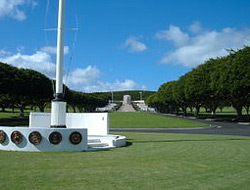The following excerpt is from a very interesting article by Ray Tsuchiyama about the “punchbowl,” or the “National Memorial Cemetery of the Pacific” located above Honolulu, on the Hawaiian Island of Oahu. It’w well worth the read at the Maui News website.

Above-listed is the official name, known in Hawai’i as simply “Punchbowl”, for the large green, calming dipped expanse atop an extinct volcanic tuff cone located near downtown Honolulu. According to geologic time, the cone is not that ancient, as it was blasted and formed about 75,000 to 100,000 years ago during the most “recent” period of volcanic activity on Oahu Island.
After the 1893 Overthrow, the new Republic of Hawai’i government assigned a committee to investigate various land parcels, and a committee (all pro-Republic, non-Kingdom loyalists) recommended that Punchbowl become the site for a new cemetery. However, the new pro-Dole government rejected the idea, since that would put a graveyard for all races overlooking the Republic’s new splendid capital city, and for the next fifty years, after the Territory of Hawai’i was established, the idea for a cemetery languished.*
After World War II Congress and veteran’s organizations lobbied the U.S. Department of War to accelerate the burials of the remains of thousands of GIs stored on Guam awaiting permanent burial. This was the trigger for the U.S. Army to begin planning the Punchbowl cemetery, and soon construction began.
Starting in early 1949 among the first persons to be buried at Punchbowl was Ernie Pyle, the famous war correspondent who was killed on Iwo Jima in 1945 (he was also an ex-Navy enlisted man, Seaman Third Class, which gave him great empathy for the downtrodden soldiers and sailors, especially in the Pacific War, and was beloved by millions who read his battlefield reports).
Read more about the “National Memorial Cemetery of the Pacific” at Wikipedia.